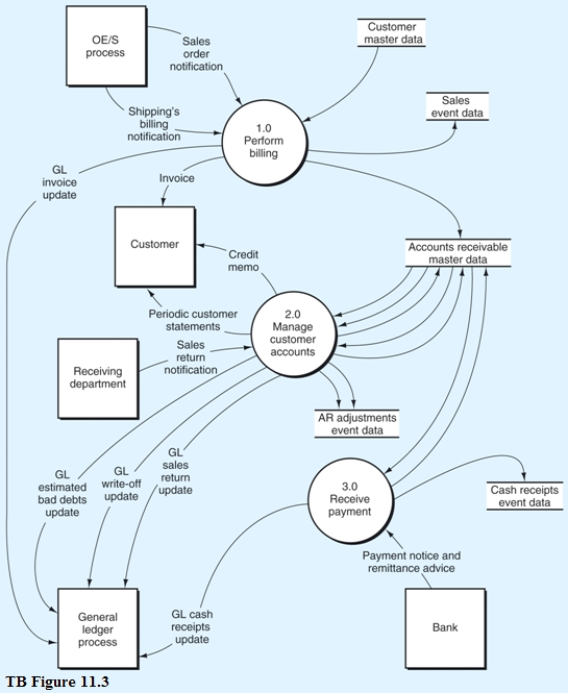Below is the narrative of the "Manage customer accounts" portion (i.e., bubble 2.0) of the B/AR/CR process.
Narrative Description
Processes 2.1 through 2.3 relate to sales returns adjustments. This process begins when there is notification from the receiving department that goods have been returned by a customer. Subprocess 2.1 obtains data from the accounts receivable master data to validate the return. If the sales return is not valid, it will be rejected (see Reject stub) and processed through a separate exception routine. If the sales return is valid, it is sent to subprocess 2.2 where a credit memo is prepared and sent to the customer, and the accounts receivable master data is updated to reflect the credit. At the same time, the validated sales return is sent to subprocess 2.3 where a journal voucher is prepared, which is used to create a record in the AR adjustments event data store (i.e., the journal), and the general ledger is notified that a credit memo has been issued. This results in updates to sales returns and allowances and to AR.
Process 2.4 is triggered by a periodic review of aging details obtained from the accounts receivable master data. The aging details would be used to identify and follow up on late-paying customer accounts. One of two types of adjustments might result from this review:
The recuring adgusting entry for estimated bad debts.
The periodic wite-off of "definitely warthess" customer accounts Like process 2.4, bubble 2.5, "Prepare customer statements," also is triggered by a periodic event that recurs at specified intervals, often on a monthly basis in practice. Details of unpaid invoices are extracted from the accounts receivable master data and are summarized in a statement of account that is mailed (or sent electronically) to customers.
Required:
From the DFD in TB Figure 11.3 and the narrative description above, explode bubble 2.0 into a lower-level diagram showing the details of that process.

Definitions:
Global Escalation
The process by which conflicts or situations increase in intensity or scale on a worldwide level, often leading to widespread consequences.
World War I
A global conflict that lasted from 1914 to 1918, involving many of the world's powers and marking one of the deadliest conflicts in history.
Q7: Payments not typically supported by invoices include:<br>A)
Q17: Which control is most likely to address
Q22: A "blind" copy of the purchase order
Q26: The stub attached to the customer statement
Q39: Production is initiated as individual sales orders
Q48: The _ is a compilation of open
Q67: The vendor sends a(n) _ to notify
Q96: Which of the following payroll-related frauds may
Q98: Computer-aided manufacturing (CAM) is the application of
Q114: In an AP/CD process, a frequent exception